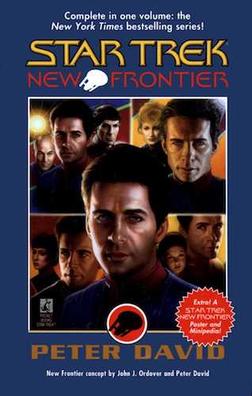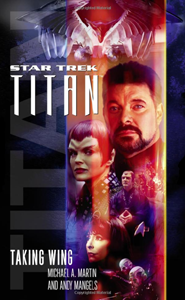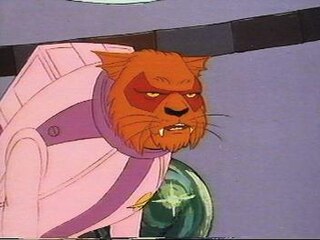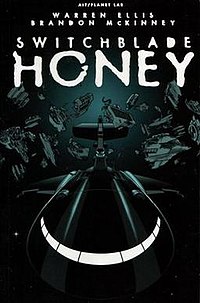In the Star Trek science-fiction franchise, the Maquis are a 24th-century paramilitary organization-terrorist group. The group is introduced in the two-part episode "The Maquis" of the television series Star Trek: Deep Space Nine, building on a plot foundation introduced in the episode "Journey's End" of Star Trek: The Next Generation, and appear in later episodes of those two series as well as Star Trek: Voyager. The Maquis story debuted when three Star Trek television shows running from 1987 to 2001 took place in the same fictional science-fiction universe at the same time in the future. As a result, the Maquis story was told across several episodes in all three shows. The Maquis are especially prominent in Star Trek: Voyager, as the fundamental premise of the series is that a Starfleet crew and a Maquis crew are stranded together on the opposite side of the Galaxy.
Enterprise or USS Enterprise is the name of several fictional spacecraft, some of which are the main craft and setting for various television series and films in the Star Trek science fiction franchise. The most notable were Captain James T. Kirk's USS Enterprise (NCC-1701) from the original 1960s television series, and Captain Jean-Luc Picard's USS Enterprise (NCC-1701-D) from Star Trek: The Next Generation.

Walter Matthew Jefferies was an American aviation and mechanical artist, set designer, and writer. He is best known for his work on the original Star Trek television series, where he designed many of the sets and props, including the original Starship Enterprise, and the bridge and sick bay.

Military science fiction is a subgenre of science fiction that depicts the use of science fiction technology, including spaceships and weapons, for military purposes and usually principal characters who are members of a military organization, usually during a war; occurring sometimes in outer space or on a different planet or planets. It exists in a range of media, including literature, comics, film, television and video games.

"Where no man has gone before" is a phrase made popular through its use in the title sequence of the original 1966–1969 Star Trek science fiction television series, describing the mission of the starship Enterprise. The complete introductory speech, spoken by William Shatner as Captain James T. Kirk at the beginning of each episode, is:
Space: the final frontier. These are the voyages of the starship Enterprise. Its five-year mission: to explore strange new worlds; to seek out new life and new civilizations; to boldly go where no man has gone before!

Montgomery "Scotty" Scott is a fictional character in the science fiction franchise Star Trek. First portrayed by James Doohan in the original Star Trek series, Scotty also appears in the animated Star Trek series, 10 Star Trek films, the Star Trek: The Next Generation episode "Relics", and in numerous books, comics, and video games.

Star Trek: New Frontier is a series of interlinked novels written by Peter David, published by Simon & Schuster imprints, Pocket Books, Pocket Star, and Gallery Books, from 1997 to 2015. New Frontier was the first Star Trek tie-in fiction property not to be based on a television series. The series was created by John J. Ordover.

The USS Enterprise NCC-1701-E is a fictional starship belonging to the United Federation of Planets, commonly known as the Federation, in the Star Trek franchise. It appears in the films Star Trek: First Contact, Star Trek: Insurrection and Star Trek: Nemesis, where it serves as the primary setting. It is the sixth Federation starship to carry the name "Enterprise". The ship's captain during the 2370s and early 2380s was Jean-Luc Picard. He was transferred to the Enterprise-E after the Enterprise-D was destroyed in The Next Generation spin-off movie Star Trek Generations.
"The Enterprise Incident" is the second episode of the third season of the American science fiction television series Star Trek. Written by D. C. Fontana and directed by John Meredyth Lucas, it was first broadcast September 27, 1968.

Star Trek: Titan is a series of science fiction novels set within the Star Trek media franchise, which detail the adventures of the USS Titan under the command Captain William T. Riker, who was part of the main cast the 1987-1994 TV series Star Trek: The Next Generation and its spinoff films. The series was published by Simon & Schuster imprints Pocket Books, Pocket Star, and Gallery Books from 2005 to 2017. The novels are set after the events depicted in the 2002 film Star Trek: Nemesis.

The supersoldier is a fictional concept soldier, often capable of operating beyond normal human limits or abilities either through genetic modification or cybernetic augmentation.
"Starship Mine" is the 144th episode of the American science fiction television series Star Trek: The Next Generation, the 18th episode of the sixth season. The episode features Tim Russ in a guest role, before he played the role of Tuvok on Star Trek: Voyager.
"The Counter-Clock Incident" is the series finale of the American animated science fiction television series Star Trek, the 22nd episode overall. This episode was the sixth and final episode of the second season. It first aired in the NBC Saturday morning lineup on October 12, 1974, and was written by Fred Bronson under the pen name "John Culver". Bronson used a pen name because he was NBC's publicist at the time and was concerned that it would look improper to get a screen credit. Bronson would eventually work on two Next Generation episodes.

"The Slaver Weapon" is the fourteenth episode of the first season of the American animated science fiction television series Star Trek: The Animated Series. It first aired on NBC on December 8, 1973, and was written by Larry Niven. It was based on his original short story "The Soft Weapon". This episode was expanded to become the first half of a full-length novel by science-fiction author Alan Dean Foster as Star Trek Log Ten.
Star Trek fan productions are productions made by fans using elements of the Star Trek franchise. Paramount Pictures, CBS, and their licensees are the only organizations legally allowed to create commercial products with the Star Trek name and trademark. The fan film community has received some coverage from the mainstream media.
"The Time Trap" is the twelfth episode of the first season of the American animated science fiction television series Star Trek. It first aired in the NBC Saturday morning lineup on November 24, 1973, and was written by American actress and screenwriter Joyce Perry.
Star Trek is an American science fiction media franchise created by Gene Roddenberry, which began with the eponymous 1960s television series and quickly became a worldwide pop-culture phenomenon. The franchise has expanded into various films, television series, video games, novels, and comic books. With an estimated $10.6 billion in revenue, it is one of the most recognizable and highest-grossing media franchises of all time.
The following outline is provided as an overview of and topical guide to Star Trek:
Star Trek: Planet of the Titans, also known as Star Trek: Planet of Titans, is an unproduced film based on Star Trek, which reached the script and design phases of pre-production. Following the success of Star Trek in broadcast syndication during the early 1970s and the popularity of the series at science-fiction conventions, Paramount Studios made several attempts to produce a feature film based upon the series. In 1975, Star Trek: The God Thing was proposed by franchise creator Gene Roddenberry but was not picked up by the studio.
Star Trek: Lower Decks is an American adult animated television series created by Mike McMahan for the streaming service Paramount+. It is the ninth Star Trek series and debuted in 2020 as part of executive producer Alex Kurtzman's expanded Star Trek Universe. Lower Decks is the franchise's first animated series since the 1970s series Star Trek: The Animated Series, and its first comedic series. It follows the low-ranking support crew of the starship Cerritos beginning in the year 2380.









